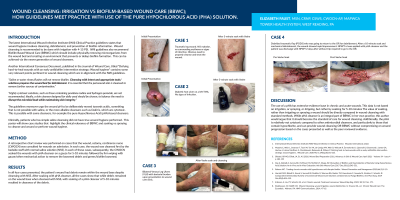Back

Case Series/Study
(CS-041) Wound cleansing: Irrigation vs biofilm based wound care (BBWC). How guidelines meet practice

Co-Author(s):
<b>Introduction</b>: <span style="font-size: 11.0pt; line-height: 107%; font-family: 'Calibri',sans-serif; mso-ascii-theme-font: minor-latin; mso-fareast-font-family: Calibri; mso-fareast-theme-font: minor-latin; mso-hansi-theme-font: minor-latin; mso-bidi-font-family: 'Times New Roman'; mso-bidi-theme-font: minor-bidi; mso-ansi-language: EN-US; mso-fareast-language: EN-US; mso-bidi-language: AR-SA;">The latest IWII Wound Infection in Clinical Practice Guidelines states that wound hygiene involves cleansing, debridement, and prevention of biofilm reformation.<span style="mso-spacerun: yes;"> </span>Wound cleansing is recommended to be done with irrigation with 4-15 PSI.<span style="mso-spacerun: yes;"> </span>IWII also recommends Biofilm Based Wound Care (BBWC) which should include physically removing microorganisms from the wound bed and creating an environment that prevents or delays biofilm formation.<span style="mso-spacerun: yes;"> </span></span><br/><br/><b>Methods</b>: <span style="font-size: 11.0pt; line-height: 107%; font-family: 'Calibri',sans-serif; mso-ascii-theme-font: minor-latin; mso-fareast-font-family: Calibri; mso-fareast-theme-font: minor-latin; mso-hansi-theme-font: minor-latin; mso-bidi-font-family: 'Times New Roman'; mso-bidi-theme-font: minor-bidi; mso-ansi-language: EN-US; mso-fareast-language: EN-US; mso-bidi-language: AR-SA;">A retrospective chart review was performed on cases that the wound, ostomy, continence nurse (CWOCN) was consulted for wounds on admission. In each case, the wound was cleansed by the bedside staff with normal saline solution (NSS). In each of these cases, the CWOCN soaked the wounds with pHA cleanser on a gauze for 5-10 minutes followed by firm wiping with gauze/other mechanical action to remove the loosened debris and germs/biofilm loosened. </span><br/><br/><b>Results</b>: <span style="font-size: 11.0pt; line-height: 107%; font-family: 'Calibri',sans-serif; mso-ascii-theme-font: minor-latin; mso-fareast-font-family: Calibri; mso-fareast-theme-font: minor-latin; mso-hansi-theme-font: minor-latin; mso-bidi-font-family: 'Times New Roman'; mso-bidi-theme-font: minor-bidi; mso-ansi-language: EN-US; mso-fareast-language: EN-US; mso-bidi-language: AR-SA;">In all five cases, the patient’s wound had debris remain within the wound base despite cleansing with NSS. After soaking with pHA cleanser, all the cases show that while debris remained on the wound base when cleansed with NSS, with soaking of a pHA cleanser of 5-10 minutes resulted in clearance of the debris.</span><br/><br/><b>Discussion</b>: <span style="font-size: 11.0pt; line-height: 107%; font-family: 'Calibri',sans-serif; mso-ascii-theme-font: minor-latin; mso-fareast-font-family: Calibri; mso-fareast-theme-font: minor-latin; mso-hansi-theme-font: minor-latin; mso-bidi-font-family: 'Times New Roman'; mso-bidi-theme-font: minor-bidi; mso-ansi-language: EN-US; mso-fareast-language: EN-US; mso-bidi-language: AR-SA;">The use of a pHA has extensive evidence base in chronic and acute wounds. This data is not based on irrigation, but rather soaking.<span style="mso-spacerun: yes;"> </span>The value of soaking, rather than irrigating or spraying a wound should be directly compared in wound cleansing with standard methods.<span style="mso-spacerun: yes;"> </span>While pHA cleanser is an integral part of BBWC, this author would argue that it should become the standard of care for wound cleansing. Additionally, the pHA is not cytotoxic can provide wound cleansing OR BBWC without compromising on wound progression. </span><br/><br/><b>Trademarked Items</b>: <br/><br/><b>References</b>: 1. Sibbald, GR MD, Elliott, JA. Et. Al. (2021) Wound Bed Preparation 2021, Advances in Skin & Wound Care: April 2021 - Volume 34 - Issue 4 - p 183-195 doi: 10.1097/01.ASW.0000733724.87630.d6
2. Day A, Alkhalil A, Carney BC, Hoffman HN, Moffatt LT, Shupp JW. Disruption of Biofilms and Neutralization of Bacteria Using Hypochlorous Acid Solution: An In Vivo and In Vitro Evaluation. Adv Skin Wound Care 2017 Dec;30(12):543-551. https://pubmed.ncbi.nlm.nih.gov/29140837/
3. Robson MC. Treating chronic wounds with hypochlorous acid disrupts biofilm. Wound Prevention and Management 2020;66 (5):9-10.https://www.todayswoundclinic.com/articles/treating-chronic-wounds-hypochlorous-acid-disrupts-biofilm
4. Harriott MM, Bhindi N, Kassis S, Summitt B, Perdikis G, Wormer BA, Rankin TM, Kaoutzanis C, Samaha M, Stratton C, Schmitz JE. Comparative Antimicrobial Activity of Commercial Wound Care Solutions on Bacterial and Fungal Biofilms. Ann Plast Surg. 2019 Oct;83(4):404-410. doi: 10.1097/SAP.0000000000001996. PMID: 31524733; PMCID: PMC6750017. https://pubmed.ncbi.nlm.nih.gov/31524733/
5. International Wound Infection Institute (IWII) Wound Infection in Clinical Practice. Wounds International, 2022.
6. Eriksson, E, Liu, PY, Schultz, GS, et al. Chronic wounds: Treatment consensus. Wound Rep Reg. 2022; 30( 2): 156- 171. doi:10.1111/wrr.12994
7. Rodeheaver, GT, Ratliff, CR. Wound Cleansing, wound irrigation, wound disinfection. In: Krasner DL, ed. Chronic Wound Care: The Essentials. Malvern, PA: HMP Communications, 2014; 47-62<br/><br/>
2. Day A, Alkhalil A, Carney BC, Hoffman HN, Moffatt LT, Shupp JW. Disruption of Biofilms and Neutralization of Bacteria Using Hypochlorous Acid Solution: An In Vivo and In Vitro Evaluation. Adv Skin Wound Care 2017 Dec;30(12):543-551. https://pubmed.ncbi.nlm.nih.gov/29140837/
3. Robson MC. Treating chronic wounds with hypochlorous acid disrupts biofilm. Wound Prevention and Management 2020;66 (5):9-10.https://www.todayswoundclinic.com/articles/treating-chronic-wounds-hypochlorous-acid-disrupts-biofilm
4. Harriott MM, Bhindi N, Kassis S, Summitt B, Perdikis G, Wormer BA, Rankin TM, Kaoutzanis C, Samaha M, Stratton C, Schmitz JE. Comparative Antimicrobial Activity of Commercial Wound Care Solutions on Bacterial and Fungal Biofilms. Ann Plast Surg. 2019 Oct;83(4):404-410. doi: 10.1097/SAP.0000000000001996. PMID: 31524733; PMCID: PMC6750017. https://pubmed.ncbi.nlm.nih.gov/31524733/
5. International Wound Infection Institute (IWII) Wound Infection in Clinical Practice. Wounds International, 2022.
6. Eriksson, E, Liu, PY, Schultz, GS, et al. Chronic wounds: Treatment consensus. Wound Rep Reg. 2022; 30( 2): 156- 171. doi:10.1111/wrr.12994
7. Rodeheaver, GT, Ratliff, CR. Wound Cleansing, wound irrigation, wound disinfection. In: Krasner DL, ed. Chronic Wound Care: The Essentials. Malvern, PA: HMP Communications, 2014; 47-62<br/><br/>

.png)